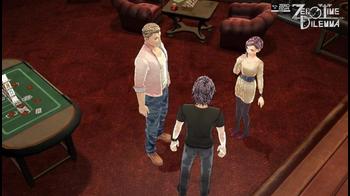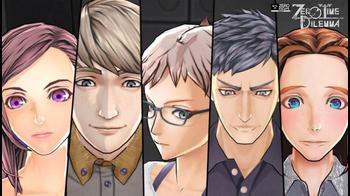
Zero Time Dilemma Review
Do you remember that movie Groundhog Day? You know, the one where Bill Murray becomes trapped in a time loop, reliving the same day over and over again. That same basic concept applies to Zero Time Dilemma – and much like Bill Murray’s character, you’ll be confused, make rash decisions, and eventually become driven to find the truth.
As the third entry in the Zero Escape series, Zero Time Dilemma, or ZTD, marks the continuation of a story foundation built across both 9 Hours, 9 Persons, 9 Doors and Virtue’s Last Reward. Similar to its predecessors, ZTD incorporates a mix of visual novel story-telling and puzzle solving action.
While we won’t tread too far into spoiler territory here, we’ll say this – if you haven’t played the other two games first, we strongly recommend doing so. ZTD is a game that directly links to its predecessors with returning characters and heavy references to them. Thus, prior knowledge is key to understanding the entire story in this game.
Zero Time Dilemma begins abruptly as an enigmatic individual, known as Zero, appears before the main cast and offers them a choice – which side will a coin will land on. Is it red? Or is it blue? Make the correct choice and you’re free to leave; simple as that. If you’re wrong, however, you’ll be forced to stay and work your way through a particular set of life or death trials.
You’re then given the choice to play as one of three teams – C Team, Q Team or D Team. Now it doesn’t really matter which one you go with first as you’ll end up completing each one eventually, but regardless the game lets you pick and choose various “memory fragments” from other teams as you go. The game’s timeline is laid out in a branching flow-chart, making it easier to understand which direction you’re steering the narrative.
Fragments themselves fall into the following categories: fully-voiced cinematic cutscenes that push the story forward, escape rooms where you’re tasked to solve a number of puzzles to seek a way out, and finally, the Decision Game. This Decision Game requires the player to make a choice, usually between two outcomes and sometimes based on a timer. Depending on your choice, the story branches out into multiple paths. Will you pull a gun’s trigger? Or let the timer countdown to zero? Ultimately it’s up to you and you’ll face the consequences through a series of twists, turns and maybe, an untimely ending awaits you.
You'll find yourself going through these series of fragments over and over again from specific points to fish for different outcomes. It’s a tad insane in theory, but it somehow works in practice as you reach bad endings and cliffhangers that require more information to proceed. Going back on a bad end is fairly easy – just select the fragment again from the game’s menu and try again. Not everything is available to you right away though. You’ll be going back and forth from team to team to try and piece together the entire, fragmented narrative.
Since the story is such a critical pillar of ZTD, we can’t delve too much into what happens. Whether you’re a series veteran or a fresh newcomer, this game is a narrative rollercoaster from start to finish. Just like the other Zero Escape titles, things never seem to be the way they are and just when you think you’ve figured out something, the actual truth is much more radically complex.
Watching the ramifications of certain decisions spiraling into a series of thrilling incidents left us speechless, shocked, depressed, excited, and downright awed. Zero Time Dilemma’s plot is its strongest factor and the fascination of the unknown kept striking us throughout the 25-30 hour experience.
The shift to cinematic cutscenes over the more visual novel-esque arrangement in its predecessors works to a certain degree, but not without its share of problems. In 9 Hours, 9 Persons, 9 Doors and Virtue’s Last Reward, character interaction was presented through dialogue boxes and character portraits. It wasn’t until Virtue’s Last Reward that voice acting was introduced to the cast (aside from its main character, Sigma).
With inconsistently stilted voice acting and subpar animations, Zero Time Dilemma is a mixed bag when its cinemas play out. Some characters, like Carlos and Phi, usually give great performances even in dire situations, but other cast members, especially Akane and Mira, provide underwhelming voice work that negatively impacts a few key scenes. The game also includes a Japanese voice track that offers more reliable quality in its voice production at the cost of some mistimed lip syncing.
Character movement in cutscenes feel stiff and never quite nails a natural flow to how their limbs move. When the 3D character models need to make a sudden motion, it often comes off rigidly in an odd robotic sort of way. Scenes involving environmental collisions lack the oomph to properly communicate meaningful impact because of how awkward the models move.
There are several benefits to this stark change in format though. ZTD is much more action-packed in its depiction of events; the game wants to convey that characters are always on the move as their nightmarish shelter devises new ways to threaten their lives. The cinematics also help build up a sense of urgency when the Decision Game interface pops on screen; tension is rightfully pre-established before it’s time to decide.
As for the escape room segments, titled as Quests in-game, their basic structure is identical to the previous games in the series – both their pros and cons as well. You’ll be tasked with finding clues in a designated room to further interact with devices inside it. Sometimes you may have to power some generators on and other times you have to combine items you’ve found in your inventory to unlock a contraption to fiddle with.
Each room is uniquely varied from one another; no two environments are identical and all of them have their own theme with exclusive mechanisms in place for you to figure out. Characters have little snippets of unvoiced dialogue that provide some adorable flavor text and sprinkles of humor granting a small peaceful reprieve from the grim circumstances.
Some of the Quest sections overstay their welcome with some repetitive puzzle design though. There are a few activities that’ll be all too familiar because you’ve done them again, and again, and again sometimes even in that same room. While a few of the rooms kept things entertainingly varied throughout their whole duration, we wished that there was just a bit more variance in the overall pool of puzzles to prevent this from happening.
Puzzles in ZTD are challenging at times and you’ll stumble across a few rooms that may stump you for awhile. Each of us had a different set of rooms that completely frustrated us and oddly enough, it added a charming aspect to it since we were able to share these vexations with one another as we gauged how our minds operated on a logical level.
Though ZTD’s Quest sections are not consistently great, they do a decent job at testing your skills of interpreting how certain parts fit into the overall whole. An in-game memo pad lets you take notes with a variety of color options to differentiate details from one another, but we both found it more convenient to just have separate notepads to scribble those down.
As for its technical performance, a shorter development time is slightly visible in an overall diminished amount of polish to the visuals, but Zero Time Dilemma is still a well-rounded game on both formats. The Vita version stands out for having higher resolution textures and a more sharper image. Meanwhile, the 3DS version looks decent, but it does suffer from some minor loading times and frequent framerate issues. The lowered visual quality is most apparent during Quest sections, with some objects harder to spot than others that often lead to a bit of frustration.
The Zero Escape series has always been accompanied by its strong sound design and Zero Time Dilemma is no exception. Series composer Shinji Hosoe returns with a familiar, but chilling, score adding an appropriate atmospheric pressure alongside a deep feeling of dread throughout the narrative. Each of the three ZTD teams have a unique set of tracks that reinforce the spirit of the past two games with the C Team and D Team playing excellently remixed tunes from 9 Hours, 9 Persons, 9 Doors and Virtue's Last Reward respectively. Meanwhile, Q Team carries brand-new tracks that allow Hosoe to establish fresh melodies to haunt your ears.
On the game's default settings, however, the music often drowns out much of the game's voice acting so we recommend turning things down a notch or two on your first time through. You'll have the option to adjust each of these in the Options menu.
It's hard not to dwell on Zero Time Dilemma. We both have for several days now and it's become clear there's something missing; something the game didn't quite grasp. Virtue’s Last Reward, for example, had a shock factor behind it because it distanced itself so far from 9 Hours, 9 Persons, 9 Doors. When things from 999 were revealed in VLR, it felt more impactful on a fundamental level.
On the other hand, ZTD's capability to wield the potential for similar surprises felt limited from the get-go due to its chronological position in the Zero Escape series. Stifled production values also affected the overall presentation negatively, it feels like both of Zero Time Dilemma's predecessors were a more focused, refined experience.
Plus, we also had hoped that Zero Time Dilemma would tie-up a few loose ends that dwelled in our minds from Virtue's Last Reward. While the game does a spectacular job unifying the other Zero Escape titles with certain characters, some significant elements remain unanswered; it was difficult for us to get a complete sensation of closure when all was said and done.
We were also frustrated that accessing the game's epilogue was tucked behind a few memo notes and the game gave no indication of them until we stumbled across them by chance.
Overall, we still firmly believe Zero Time Dilemma is a great conclusion to the Zero Escape series. Its incredible storytelling through fragmented scenes fittingly structures the entire plot as a puzzle that the player pieces together one at a time. Several characters we've come to hate and love throughout the series now have a conclusive explanation to the situations they faced in the other games. While some of its flaws may leave some areas feeling half-baked, Zero Time Dilemma will be something that won't be leaving our minds anytime soon.



